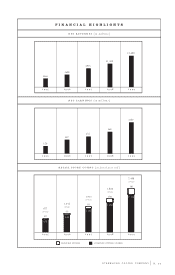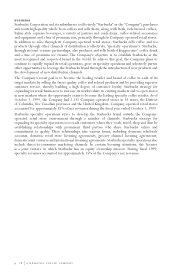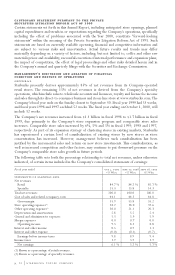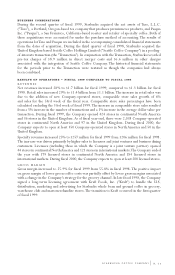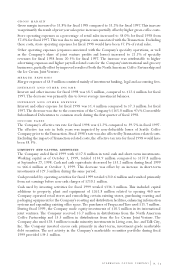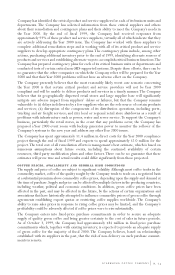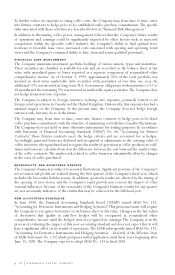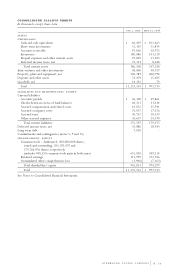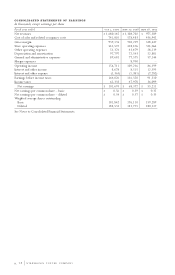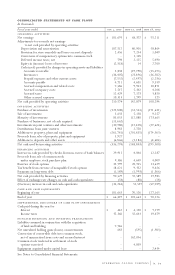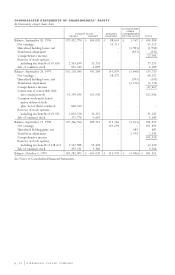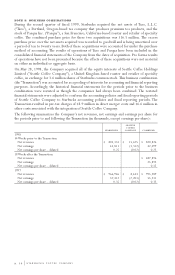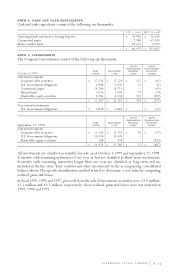Starbucks 1999 Annual Report Download - page 9
Download and view the complete annual report
Please find page 9 of the 1999 Starbucks annual report below. You can navigate through the pages in the report by either clicking on the pages listed below, or by using the keyword search tool below to find specific information within the annual report.
Company has identified the critical product and service suppliers for each of its business units and
departments. The Company has solicited information from these critical suppliers and others
about their remediation and contingency plans and their ability to meet the Company’s needs in
the Year 2000. By the end of fiscal 1999, the Company had received responses from
approximately 93% of these product and service suppliers, virtually all of which indicate that they
are actively addressing the Year 2000 issue. The Company has worked with these suppliers to
complete additional remediation steps and is working with all of its critical product and service
suppliers to develop appropriate contingency plans.The contingency plans include, among other
actions, purchasing additional inventory prior to the end of 1999, identifying alternate sources of
products and services and establishing alternate ways to accomplish critical business functions.The
Company has prepared contingency plans for each of its critical business units or departments and
conducted tests of certain critical non-MIS-supported systems. Despite these efforts, there can be
no guarantee that the other companies on which the Company relies will be prepared for the Year
2000 and that their Year 2000 problems will not have an adverse effect on the Company.
The Company presently believes that the most reasonably likely worst case scenario concerning
the Year 2000 is that certain critical product and service providers will not be Year 2000
compliant and will be unable to deliver products and services in a timely manner. The Company
believes that its geographically dispersed retail stores and large supplier base will significantly
mitigate any adverse impact from suppliers’ delays or failures, but that the Company remains
vulnerable to (i) delays in deliveries by a few suppliers who are the sole source of certain products
and services; (ii) disruption of the components of its distribution operations, including ports,
trucking and air freight services; and (iii) local or regional retail store shutdowns as a result of
problems with infrastructure such as power, water and sewer service.To support the Company’s
business, particularly the retail stores, in the event that any problems occur, the Company has
prepared a Year 2000 event room with backup generator power to monitor the rollover of the
Company’s systems to the new year and address any other Year 2000 issues.
The Company has spent approximately $1.4 million in direct costs for the Year 2000 compliance
project through the end of fiscal 1999 and expects to spend approximately $2.0 million for the
project.The total cost of all remediation efforts is management’s best estimate, which is based on
numerous assumptions about future events, including the continued availability of certain
resources, third party modification plans and other factors. There can be no guarantee that these
estimates will prove true and actual results could differ significantly from those projected.
COFFEE PRICES, AVAILABILITY AND GENERAL RISK CONDITIONS
The supply and price of coffee are subject to significant volatility. Although most coffee trades in the
commodity market, coffee of the quality sought by the Company tends to trade on a negotiated basis
at a substantial premium above commodity coffee prices, depending upon the supply and demand at
the time of purchase. Supply and price can be affected by multiple factors in the producing countries,
including weather, political and economic conditions. In addition, green coffee prices have been
affected in the past, and may be affected in the future, by the actions of certain organizations and
associations that have historically attempted to influence commodity prices of green coffee through
agreements establishing export quotas or restricting coffee supplies worldwide. The Company’s
ability to raise sales prices in response to rising coffee prices may be limited, and the Company’s
profitability could be adversely affected if coffee prices were to rise substantially.
The Company enters into fixed-price purchase commitments in order to secure an adequate
supply of quality green coffee and bring greater certainty to the cost of sales in future periods.
As of October 3, 1999, the Company had approximately $84 million in fixed-price purchase
commitments which, together with existing inventory, is expected to provide an adequate supply
of green coffee for the majority of fiscal 2000. The Company believes, based on relationships
established with its suppliers in the past, that the risk of non-delivery on such purchase commit-
ments is remote.
.
STARBUCKS COFFEE COMPANY

